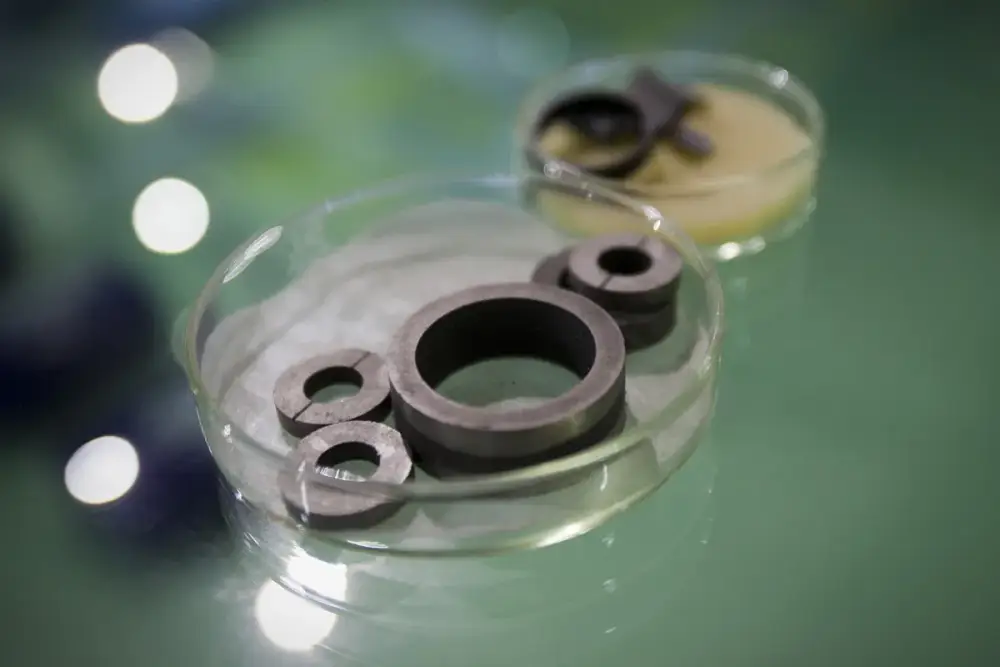
Ấn Độ tung gói 290 triệu USD sản xuất đất hiếm, quyết "thoát Trung" để bảo vệ chuỗi cung ứng xe điện
-
Chính phủ Ấn Độ chuẩn bị triển khai chương trình ưu đãi trị giá 25 tỷ rupee (tương đương khoảng 290 triệu USD) để thúc đẩy sản xuất nam châm đất hiếm trong nước, nhằm giảm lệ thuộc vào Trung Quốc – quốc gia đang chiếm khoảng 90% năng lực tinh chế đất hiếm toàn cầu.
-
Các tập đoàn lớn như Vedanta Group, JSW Group và Sona BLW Precision Forgings Ltd. đã thể hiện sự quan tâm ban đầu.
-
Kế hoạch hướng tới sản xuất 4.000 tấn nam châm dựa trên neodymium và praseodymium trong 7 năm, sử dụng nguyên liệu khai thác tại Ấn Độ.
-
Dự án bao gồm 2 năm chuẩn bị và 5 năm ưu đãi tài chính, với mức hỗ trợ lên tới 6 tỷ rupee (khoảng 70 triệu USD) cho mỗi 1.000 tấn công suất sản xuất.
-
Chính phủ sẽ tổ chức đấu thầu cho công suất sản xuất hàng năm từ 500 đến 1.500 tấn.
-
Các nhà sản xuất phải đảm bảo ít nhất 50% giá trị sản phẩm cuối cùng đến từ nguyên liệu nội địa ngay từ năm đầu, và nâng lên 80% vào năm thứ năm.
-
Sona BLW, một trong những nhà sản xuất động cơ xe điện lớn của Ấn Độ, cho biết dự án sẽ giúp bảo vệ chuỗi cung ứng và đầu tư công nghệ nội địa.
-
Tại hội nghị BRICS ở Rio de Janeiro, Thủ tướng Narendra Modi kêu gọi không quốc gia nào nên biến khoáng sản quan trọng thành vũ khí địa chính trị.
-
Tuy nhiên, dự án vẫn đối mặt với nhiều thách thức:
-
Ngân sách còn hạn chế so với quy mô và chi phí xây dựng mỏ, nhà máy xử lý.
-
Công nghệ tinh chế và kỹ thuật vẫn do Trung Quốc nắm giữ phần lớn.
-
Nguy cơ môi trường cao, do đất hiếm thường đi kèm các nguyên tố phóng xạ.
-
-
Công ty quốc doanh Khanij Bidesh India Ltd. đang đàm phán khai thác tại Argentina, Zambia và Australia để bổ sung nguồn cung ngoài nước.
📌 Ấn Độ đẩy mạnh chiến lược "thoát Trung" với gói ưu đãi trị giá 290 triệu USD nhằm sản xuất 4.000 tấn nam châm đất hiếm trong nước trong 7 năm. Vedanta, JSW và Sona BLW đã tham gia, với yêu cầu 80% nguyên liệu nội địa vào năm thứ 5. Tuy nhiên, thách thức công nghệ, môi trường và ngân sách vẫn là rào cản lớn trong mục tiêu giành lại quyền tự chủ chuỗi cung ứng chiến lược.
https://www.bloomberg.com/news/articles/2025-07-09/india-s-rare-earth-ambitions-may-draw-vedanta-jsw-to-reduce-china-reliance
India Plans to Kickstart Rare-Earth Output to Cut China Reliance
July 9, 2025 at 9:57 AM UTC
Updated on
July 9, 2025 at 10:55 AM UTC
- The Indian government is planning an incentive program for private sector firms manufacturing rare-earth magnets, with a proposed budget of as much as 25 billion rupees.
- Companies including Vedanta Group, JSW Group, and Sona BLW Precision Forgings Ltd. have shown interest in the initiative, according to people familiar with the matter.
- The program aims to support the production of about 4,000 tons of neodymium and praseodymium-based magnets over a period of seven years, using locally-mined raw materials, the people said.
A proposed plan by India to spur local production of rare-earth magnets has drawn initial interest from a clutch of large conglomerates, people familiar with the matter said, as the country seeks to cut its reliance on China for these vital electric-vehicle and wind-turbine materials.
The Indian government is planning an incentive program worth as much as 25 billion rupees ($290 million) for private sector firms manufacturing these magnets, said the people, who asked not to be named as the details are not public.
Billionaire Anil Agarwal’s mining giant Vedanta Group, Sajjan Jindal-led JSW Group and EV parts maker Sona BLW Precision Forgings Ltd. are among those who have shown keenness in this initiative.
The policy blueprint is likely to be submitted for cabinet approval soon, the people said. The final outlay for the program is subject to internal consultations and could change, they said.
India is accelerating efforts on this front after China, which controls about 90% of the world’s rare earths processing, tightened export controls on rare earths amid a trade war with the US. This has disrupted supply chains for global automobile makers, including those operating in India.
‘Don’t Weaponize’
Indian Prime Minister Narendra Modi highlighted the need for a reliable supply of critical minerals at the BRICS gathering in Rio de Janeiro over the weekend. “It’s important to ensure that no country uses these resources for its own selfish gain or as a weapon against others,” Modi said at the event.
The South Asian nation aims to support three to four large companies in the production of about 4,000 tons of neodymium and praseodymium-based magnets using locally-mined raw materials over a period of seven years, according to the people and a policy proposal seen by Bloomberg News.
There will be a two-year gestation period and incentives will be rolled out over five years following the start of manufacturing, the people said. India, with a rapidly growing electric vehicle sector, is considering an investment of up to 6 billion rupees for every 1,000 tons of capacity under the program, they added.
“Our interest in rare-earth magnet manufacturing stems from its strategic importance to green technologies,” a Vedanta spokesperson said in an email, adding that these minerals were “fast becoming new levers of global influence.”
The Ministry of Heavy Industries and JSW did not respond immediately to an email seeking comments.
Producing magnets will help secure the supply chain for Sona BLW — one of the largest Indian makers of traction motors for electric vehicles, Chief Executive Officer Vivek Vikram Singh told Bloomberg News. The company may seek a partner with a firm to develop technology for the magnets as well, Singh added.
India is mulling incentives for rare-earth magnet makers, Heavy Industries Minister H.D. Kumaraswamy said at an event in New Delhi last month, without elaborating.
While the government’s effort to boost rare earths is in line with a worldwide push, its budget is modest and its timeframe remains ambitious. Mines and processing facilities can take years to build, and know-how stays heavily concentrated in China.
Despite their name, rare earths are not geologically rare. But mining them economically is difficult, and often poses environmental risks due to their low concentrations and association with radioactive elements.
Nascent Efforts
While India has long sought to boost production either domestically or through overseas projects, those efforts remain nascent. State-owned Khanij Bidesh India Ltd. is leading initial moves with mining concessions in Latin America and is talks with Argentina, Zambia and Australia among others.
Currently, producing magnets in India without subsidies is nearly impossible. The necessary oxide is supplied by state-owned Indian Rare Earths Ltd., and a project’s return on investment in this sector is negative without both capital and operating subsidies, the people said.
According to the proposed blueprint, the government will invite companies to bid for annual production capacity between 500 tons and 1,500 tons.
Follow Bloomberg India on WhatsApp for exclusive content and analysis on what billionaires, businesses and markets are doing. Sign up here.
To qualify, manufacturers must meet strict norms, including the requirement that half of the value of the final product must come from locally produced neodymium-praseodymium oxide, an ingredient crucial for making high-performance magnets, according to the proposal.
The domestic sourcing requirement will rise to 80% by the fifth year of manufacturing, it added.
Thảo luận
Follow Us
Tin phổ biến



